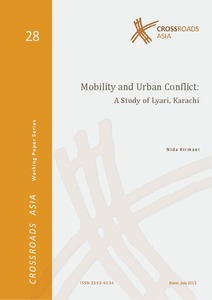Kirmani, Nida: Mobility and Urban Conflict: A Study of Lyari, Karachi. Bonn: Competence Network Crossroads Asia: Conflict – Migration – Development, 2015. In: Baldauf, Ingeborg; Conermann, Stephan; Kreutzmann, Hermann; Nadjmabadi, Shahnaz; Reetz, Dietrich; Schetter, Conrad; Sökefeld, Martin; Bech Hansen, Claus Erik; Hornidge, Anna-Katharina; Mielke, Katja (Hrsg.): Crossroads Asia Working Paper Series, 28.
Online-Ausgabe in bonndoc: https://hdl.handle.net/20.500.11811/163
Online-Ausgabe in bonndoc: https://hdl.handle.net/20.500.11811/163
@techreport{handle:20.500.11811/163,
author = {{Nida Kirmani}},
editor = {{Ingeborg Baldauf} and {Stephan Conermann} and {Hermann Kreutzmann} and {Shahnaz Nadjmabadi} and {Dietrich Reetz} and {Conrad Schetter} and {Martin Sökefeld} and {Claus Erik Bech Hansen} and {Anna-Katharina Hornidge} and {Katja Mielke}},
title = {Mobility and Urban Conflict: A Study of Lyari, Karachi},
publisher = {Competence Network Crossroads Asia: Conflict – Migration – Development},
year = 2015,
month = jun,
series = {Crossroads Asia Working Paper Series},
volume = 28,
note = {This paper […] focuses more closely on the transregional impacts of conflicts on local residents, most of whom are not themselves personally involved in these conflicts. For young Baloch men struggling to survive within Karachi, urban conflicts make their everyday lives all the more difficult. Faced with multiple forms of insecurity including physical, economic and social insecurity, these young men must tactically navigate multiple social and spatial boundaries in their everyday lives. For some of these men, migration to Iran or the Gulf presents itself as the best possible option in order to escape a city that they feel has become hostile to them. Therefore, urban conflicts had contradictory impacts on men’s mobility. While the conflict restricted the mobility of young, Baloch men within the city in a variety of ways, it also increased mobility, at least for some, across national borders. Therefore, in order to be properly understood, both the causes and consequences of urban conflicts such as those taking place in Lyari should be viewed through a transregional lens as the product of multiple forms of mobility.},
url = {https://hdl.handle.net/20.500.11811/163}
}
author = {{Nida Kirmani}},
editor = {{Ingeborg Baldauf} and {Stephan Conermann} and {Hermann Kreutzmann} and {Shahnaz Nadjmabadi} and {Dietrich Reetz} and {Conrad Schetter} and {Martin Sökefeld} and {Claus Erik Bech Hansen} and {Anna-Katharina Hornidge} and {Katja Mielke}},
title = {Mobility and Urban Conflict: A Study of Lyari, Karachi},
publisher = {Competence Network Crossroads Asia: Conflict – Migration – Development},
year = 2015,
month = jun,
series = {Crossroads Asia Working Paper Series},
volume = 28,
note = {This paper […] focuses more closely on the transregional impacts of conflicts on local residents, most of whom are not themselves personally involved in these conflicts. For young Baloch men struggling to survive within Karachi, urban conflicts make their everyday lives all the more difficult. Faced with multiple forms of insecurity including physical, economic and social insecurity, these young men must tactically navigate multiple social and spatial boundaries in their everyday lives. For some of these men, migration to Iran or the Gulf presents itself as the best possible option in order to escape a city that they feel has become hostile to them. Therefore, urban conflicts had contradictory impacts on men’s mobility. While the conflict restricted the mobility of young, Baloch men within the city in a variety of ways, it also increased mobility, at least for some, across national borders. Therefore, in order to be properly understood, both the causes and consequences of urban conflicts such as those taking place in Lyari should be viewed through a transregional lens as the product of multiple forms of mobility.},
url = {https://hdl.handle.net/20.500.11811/163}
}






